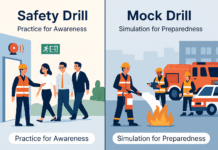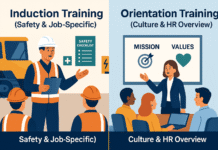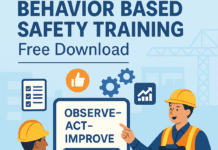
Monthly Safety Calendar
Monthly Safety Calendar : Workplace safety isn’t just a regulatory requirement; it’s a moral and strategic imperative for any responsible business. One innovative approach gaining popularity is the implementation of a Monthly Safety Calendar. In this article, we will explore the ins and outs of this proactive safety strategy, from its creation to the long-term benefits it brings to businesses.
I. Introduction
A. Definition of a Monthly Safety Calendar
A Monthly Safety Calendar is a curated schedule of safety topics and activities designed to keep workplace safety at the forefront of employees’ minds throughout the year.
B. Importance of Workplace Safety
Workplace accidents not only harm employees but can also have significant financial implications for businesses. A focus on safety is crucial for employee well-being and organizational success.
C. Purpose of Implementing a Monthly Safety Calendar
The primary purpose of implementing a Monthly Safety Calendar is to create a structured and engaging approach to safety, ensuring that it becomes an integral part of the workplace culture.
II. Creating a Monthly Safety Calendar
A. Identifying Key Safety Topics
Choosing relevant and impactful safety topics is the foundation of an effective safety calendar. Topics should address both general safety concerns and specific risks in the workplace.
B. Involving Employees in Topic Selection
Employee involvement fosters a sense of ownership and ensures that safety topics are relevant to the day-to-day experiences of the workforce.
C. Setting Realistic Safety Goals
Establishing achievable safety goals for each month provides a clear roadmap for improvement and helps in measuring the effectiveness of the safety calendar.
III. Designing Engaging Content
A. Incorporating Visuals and Infographics
Visual elements enhance the understanding and retention of safety information. Infographics can simplify complex concepts and make them more accessible.
B. Writing Clear and Concise Safety Messages
Clear and concise communication is key. Safety messages should be easy to understand and actionable, promoting immediate implementation.
C. Utilizing Varied Content Formats (Videos, Posters, Articles)
Diversifying content formats keeps safety communication fresh and engaging. Videos, posters, and articles cater to different learning preferences among employees.
IV. Implementing Safety Activities
A. Planning Monthly Safety Drills
Regular safety drills help employees practice emergency procedures, ensuring they are prepared in case of real incidents.
B. Conducting Training Sessions
Training sessions provide an opportunity to delve deeper into specific safety topics and address any questions or concerns employees may have.
C. Recognizing and Rewarding Safety Champions
Acknowledging and rewarding employees who actively contribute to a safer workplace encourages a culture of vigilance and responsibility.
V. Overcoming Challenges
A. Addressing Employee Resistance
Resistance to safety initiatives is not uncommon. Open communication about the benefits and addressing concerns can help overcome resistance.
B. Adapting to Different Work Environments
Safety calendars must be adaptable to different work environments, considering the unique challenges each setting presents.
C. Sustaining Interest Over Time
Keeping safety interesting and relevant over the long term requires creativity and a commitment to continuous improvement.
VI. Measuring and Analyzing Safety Metrics
A. Establishing Key Performance Indicators (KPIs)
Identifying KPIs helps in measuring the success of safety initiatives and allows for data-driven decision-making.
B. Using Technology for Data Collection
Leveraging technology for data collection streamlines the process and provides real-time insights into safety performance.
C. Analyzing Trends and Making Improvements
Regularly analyzing safety trends allows for continuous improvement, ensuring that safety strategies evolve with changing circumstances.
VII. Case Studies
A. Success Stories of Companies with Effective Safety Calendars
Examining success stories provides valuable insights and inspiration for businesses looking to enhance their safety programs.
B. Lessons Learned from Past Failures
Analyzing failures is equally important, as it helps in understanding pitfalls to avoid and challenges to overcome.
C. Tailoring Approaches Based on Industry
Different industries have unique safety challenges. Tailoring safety approaches based on industry-specific needs is crucial for success.
VIII. Keeping Safety Calendar Relevant
A. Regularly Updating Topics
Regular updates to safety topics keep the calendar fresh and relevant, preventing monotony and ensuring ongoing engagement.
B. Seeking Feedback from Employees
Continuous feedback from employees helps in refining the safety calendar, making it more effective and employee-friendly.
C. Adapting to Industry Changes
Staying abreast of industry changes ensures that safety calendars remain aligned with evolving best practices.
IX. Benefits of a Monthly Safety Calendar
A. Reduced Accidents and Injuries
The primary benefit of a Monthly Safety Calendar is a significant reduction in workplace accidents and injuries.
B. Improved Employee Morale
A focus on safety demonstrates a commitment to employee well-being, boosting morale and job satisfaction.
C. Positive Impact on Company Reputation
A strong safety record enhances a company’s reputation, both internally and externally.
X. Legal Compliance and Regulatory Considerations
A. Ensuring Adherence to Occupational Safety Standards
Adhering to established safety standards is not only a legal obligation but also a crucial aspect of protecting employees.
B. Updating Practices Based on Legislative Changes
Staying informed about legislative changes ensures that safety practices remain compliant and up-to-date.
C. Avoiding Common Legal Pitfalls
Understanding common legal pitfalls helps businesses avoid costly legal issues related to workplace safety.
XI. Industry-Specific Safety Measures
A. Tailoring Safety Calendars to Different Industries
Different industries face unique safety challenges. Adapting safety calendars to specific industries is essential for their effectiveness.
B. Best Practices in High-Risk Sectors
High-risk sectors require additional precautions and specialized safety measures, which should be reflected in the safety calendar.
C. Adapting General Safety Guidelines to Specific Needs
General safety guidelines can be adapted to address the specific needs of different industries and workplaces.
XII. Employee Involvement and Empowerment
A. Fostering a Culture of Safety Ownership
Encouraging employees to take ownership of safety fosters a collective responsibility for well-being.
B. Encouraging Reporting and Feedback
Creating an environment where employees feel comfortable reporting safety concerns ensures early intervention and prevention.
C. Empowering Employees to Lead Safety Initiatives
Empowering employees to take an active role in safety initiatives enhances overall program effectiveness.
XIII. Cost-Benefit Analysis
A. Evaluating the Return on Investment in Safety Programs
Conducting a cost-benefit analysis helps in understanding the financial impact of safety initiatives on the business.
B. Balancing Costs with Long-Term Safety Gains
Finding a balance between upfront costs and long-term safety gains is crucial for sustainable safety programs.
C. Making a Business Case for Safety Expenditure
Presenting a compelling business case for safety expenditure ensures that budget allocations align with organizational goals.
A monthly safety calendar can help promote a culture of safety in the workplace or community. Here’s a sample safety calendar for the month of November:
November Safety Calendar
Week 1: November 1-7 – Fire Safety Week
- Monday, Nov 1: Review evacuation routes and assembly points.
- Tuesday, Nov 2: Conduct fire drills and practice using fire extinguishers.
- Wednesday, Nov 3: Check and test smoke detectors throughout the facility.
- Thursday, Nov 4: Provide training on proper handling of flammable materials.
- Friday, Nov 5: Distribute fire safety pamphlets and emergency contact information.
Week 2: November 8-14 – Ergonomics Awareness Week
- Monday, Nov 8: Conduct ergonomic assessments of workstations.
- Tuesday, Nov 9: Provide ergonomic training for office and field workers.
- Wednesday, Nov 10: Encourage regular breaks and stretching exercises.
- Thursday, Nov 11: Display posters with ergonomic tips and guidelines.
- Friday, Nov 12: Share resources on maintaining good posture and preventing injuries.
Week 3: November 15-21 – Electrical Safety Week
- Monday, Nov 15: Inspect electrical cords and outlets for wear and tear.
- Tuesday, Nov 16: Train employees on proper use of electrical equipment.
- Wednesday, Nov 17: Conduct a review of electrical safety procedures.
- Thursday, Nov 18: Remind staff to report any electrical issues immediately.
- Friday, Nov 19: Share information on the dangers of overloading circuits.
Week 4: November 22-28 – Construction Safety Week
- Monday, Nov 22: Conduct site safety inspections and equipment checks.
- Tuesday, Nov 23: Provide training on fall protection and ladder safety.
- Wednesday, Nov 24: Emphasize the importance of personal protective equipment (PPE).
- Thursday, Nov 25: Review emergency procedures specific to construction sites.
- Friday, Nov 26: Distribute resources on preventing common construction hazards.
Week 5: November 29-30 – Winter Preparedness
- Monday, Nov 29: Prepare for winter weather – check heating systems and insulation.
- Tuesday, Nov 30: Distribute winter safety kits and cold-weather gear.
Feel free to customize this calendar based on the specific safety needs of your organization or community.
Construction Safety Calendar 2024
Workplace Safety Calendar 2024
XV. Conclusion
A. Recap of the Importance of Monthly Safety Calendars
Monthly Safety Calendars provide a structured and engaging approach to workplace safety, fostering a culture of vigilance and responsibility.
B. Encouragement for Businesses to Implement Effective Safety Strategies
Encouraging businesses to take proactive steps towards implementing effective safety strategies for the well-being of their employees and the success of their organizations.
Frequently Asked Questions (FAQs)
- Q: How can a Monthly Safety Calendar benefit my business?
- A: A Monthly Safety Calendar can significantly reduce workplace accidents, improve employee morale, and enhance your company’s reputation.
- Q: What challenges might businesses face in implementing a safety calendar?
- A: Challenges include employee resistance, adapting to different work environments, and sustaining interest over time.
- Q: How often should safety topics be updated in the calendar?
- A: Regular updates are essential to keep the calendar fresh and relevant, preventing monotony and ensuring ongoing engagement.
- Q: Are there industry-specific safety measures discussed in the article?
- A: Yes, the article covers tailoring safety calendars to different industries and best practices in high-risk sectors.
- Q: What is the future trend mentioned in workplace safety?
- A: The integration of technology, emerging concepts in employee well-being, and sustainable and eco-friendly safety practices are future trends discussed in the article.
























